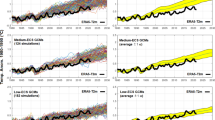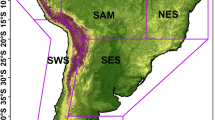Abstract
Realistic meteorological fields are a prerequisite for the determination of pollutant concentrations and depositions by means of a chemistry transport model. Different configurations of the 5th generation NCAR/Penn State University mesoscale meteorological model MM5 were tested to determine the optimum set up for long term hindcasts that cover several months up to years. Four dimensional data assimilation (FDDA) significantly enhances the spatio temporal representation of temperature, humidity and wind. Best agreement with radiosonde observations could be achieved when temperature, humidity and wind were grid nudged every 6 h. The quality of the resulting meteorological fields showed no significant systematic temporal or spatial variation over Europe in a model run of the year 2000. It was found that the hydrological cycle was not correctly reproduced by the model when no nudging was applied. The relevant model run showed too high relative humidity and too high rainfall when compared to observations. This led to considerably lower aerosol concentrations close to ground and a shift in the deposition patterns of particle bound pollutants like the carcinogenic benzo(a)pyrene (B(a)P).
Similar content being viewed by others
References
Aulinger A, Matthias V, Quante M (2007) Introducing a partitioning mechanism for PAHs into the Community Multiscale Air Quality modelling system and its application to simulating the transport of benzo(a)pyrene over Europe. J Appl Meteorol 46(11): 1718–1730
Bessagnet B, Hodzic A, Vautard R, Beekmann M, Cheinet S, Honore C, Liousse C, Rouil L (2004) Aerosol modeling with CHIMERE—preliminary evaluation at the continental scale. Atmos Environ 38(18): 2803–2817
Binkowski F, Roselle S (2003) Models-3 Community Multiscale Air Quality (CMAQ) model aerosol component. 1. Model description. J Geophys Res 108(D6): 4183 doi:10.1029/2001JD001409
Binkowski FS, Shankar U (1995) The regional particulate matter model. 1. Model description and preliminary results. J Geophys Res-Atmos 100(D12): 26,191–26,209
Bouttier F (2001) The use of profiler data at ECMWF. Meteorol Z 10(6): 497–510
Byun D, Ching J (1999) Science algorithms of the EPA Models-3 Community Multiscale Air Quality modeling system. EPA/600/R-99/030. US Environmental Protection Agency, Office of Research and Development, Washington, DC
Byun D, Schere K (2006) Review of the governing equations, computational algorithms, and other components of the Models-3 Community Multiscale Air Quality (CMAQ) modeling system. Applied Mech Rev 59: 51–77
Chen F, Dudhia J (2001) Coupling an advanced land-surface/hydrology model with the Penn State/NCAR MM5 modeling system. Part I: Model implementation and sensitivity. Monthly Weather Rev 129: 569–585
Colle B, Olson J, Tongue J (2003) Multiseason Verification of the MM5 Part II Evaluation of High-Resolution Precipitation Forecasts over the Northeastern United States. Bull Am Meteorol Soc 18: 458–480
Denier van der Gon H, van het Bolscher M, Visschedijk A, Zandveld P (2005) Study of the effectiveness of UNECE Persistent Organic Pollutants Protocol and cost of possible additional measures. Phase I: estimation of emission reduction resulting from the implementation of the POP Protocol. TNO report B& O-A R 2005/194, TNO, Appeldoorn, The Netherlands
Durre I, Vose RS, Wuertz DB (2006) Overview of the integrated global radiosonde archive. J Clim 19: 53–68
Friedrich R, Reis S (2004) Emissions of air pollutants. Springer, Berlin
Gery MW, Whitten GZ, Killus JP, Dodge MC (1989) A photochemical kinetics mechanism for urban and regional scale computer modeling. J Geophys Res 94: 12,925–12,956
Gilliam R, Hogrefe C, Rao ST (2006) New methods for evaluating meteorological models used in air quality applications. Atmos Environ 40: 5073–5086
Grell G, Dudhia J, Stauffer DR (1995) A description of the Fifth-Generation Penn State/NCAR Mesoscale Model (MM5). NCAR Technical Note 398, NCAR, Boulder, Colorado
Hong SY, Pan HL (1996) Nonlocal boundary layer vertical diffusion in a medium-range forecast model. Monthly Weather Rev 124: 2322
Jakobs HJ, Feldmann H, Hass H, Memmesheimer M (1995) The use of nested models for air pollution studies: an application of the EURAD model to a SANA episode. J Appl Meteorol 34(6): 1301–1319
Kain JS (2004) The Kain-Fritsch convective parameterization: an update. J Appl Meteorol 43: 170–181
Klein Tank AMG, Wijngaard JB, Konnen GP, Bohm R, Demaree G, Gocheva A, Mileta M, Pashiardis S, Hejkrlik L, Kern-Hansen C, Heino R, Bessemoulin P, Muller-Westermeier G, Tzanakou M, Szalai S, Palsdottir T, Fitzgerald D, Rubin S, Capaldo M, Maugeri M, Leitass A, Bukantis A, Aberfeld R, Van Engelen AFV, Forland E, Mietus M, Coelho F, Mares C, Razuvaev V, Nieplova E, Cegnar T, Lopez JA, Dahlstrom B, Moberg A, Kirchhofer W, Ceylan A, Pachaliuk O, Alexander LV, Petrovic P (2002) Daily dataset of 20th-century surface air temperature and precipitation series for the European Climate Assessment. Int J Climatol 22(12): 1441–1453
Matthias V (2008) The aerosol distribution in Europe derived with the Community Multiscale Air Quality (CMAQ) model: Comparison to near surface in situ and sunphotometer measurements. Atmospheric Chemistry Physics 8: 5077–5097
Memmesheimer M, Jakobs HJ, Piekorz G, Ebel A, Kerschgens MJ, Friese E, Feldmann H, Geiß H (2001) Air quality modeling with the EURAD model. In: Proceedings of the 7th international conference on harmonisation within atmospheric dispersion modelling for regulatory purposes. Belgirate
Reisner J, Rasmussen RJ, Bruintjes RT (1998) Explicit forecasting of supercooled liquid water in winter storms using the MM5 mesoscale model. Q J R Meteorol Soc 124B: 1071
Schell B, Ackermann IJ, Hass H, Binkowski FS, Ebel A (2001) Modelling the formation of secondary organic aerosol within a comprehensive air quality model system. J Geophys Res 2106(D22): 28,275–28,293
Schmidt H, Derognat C, Vautard R, Beekmann M (2001) A comparison of simulated and observed ozone mixing ratios for the summer of 1998 in Western Europe. Atmos Environ 35(36): 6277–6297
Stauffer DR, Seaman NL (1990) Use of 4-dimensional data assimilation in a limited-area mesoscale model. 1. Experiments with synoptic-scale data. Monthly Weather Rev 118(6): 1250–1277
Vestreng V, Klein H (2002) Emission data reported to UNECE/EMEP: quality assurance and trend analysis & presentation of WebDab. EMEP/MSC-W Note 1/2002. Norwegian Meteorological Institute, Oslo, Norway
Author information
Authors and Affiliations
Corresponding author
Additional information
Guest Editor: Dr. S. T. Rao.
Rights and permissions
About this article
Cite this article
Matthias, V., Quante, M. & Aulinger, A. Determination of the optimum MM5 configuration for long term CMAQ simulations of aerosol bound pollutants in Europe. Environ Fluid Mech 9, 91–108 (2009). https://doi.org/10.1007/s10652-008-9103-6
Received:
Accepted:
Published:
Issue Date:
DOI: https://doi.org/10.1007/s10652-008-9103-6




